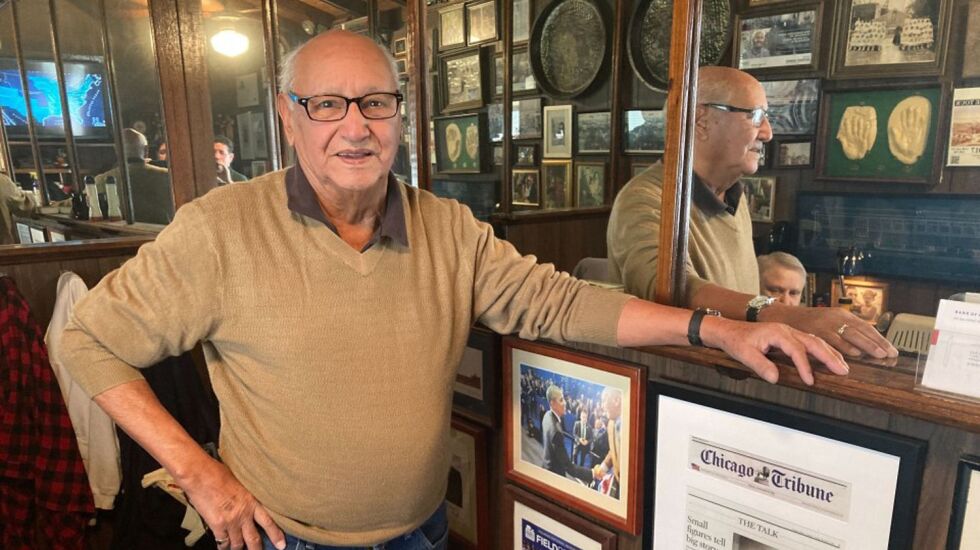
WBEZ’s Michael Puente spoke with Alfonzo Quiroz, who worked in the area, Mark Bouman, the Field Museum’s Chicago region program director, and Janet Hong, senior project manager at the museum, for this report on “Calumet Voices, National Stories” — a new exhibition at the museum on the Calumet region, its culture and heritage.
Michael Puente: Alfonso Quiroz walked four blocks nearly every day for more than two decades to get to his job installing doors inside passenger trains for the Pullman Company. He’d often take his own lunch.
Alfonzo Quiroz: I brought my lunch bucket. Over 22 years, going to work every day, walking to work every day. And I brought my ham-and-cheese sandwich and a thermos full of hot coffee.
Puente: Quiroz, whose parents were Mexican immigrants, never thought that black steel lunch pail he bought at Sears in the 1950s would one day be on display in a museum — the Field Museum, no less.
Quiroz: Like I say, if the lunch bucket can talk, it could tell you some real good stories.
Puente: After Pullman closed in 1981, Quiroz worked two more years at the company’s other plant, in Hammond, Indiana — just a couple of miles away from his home, where he still lives. The 86-year-old says even though there are two states, the connections with other industrial cities — like Blue Island, Gary and Michigan City — make the Calumet region unique.
Quiroz: There’s a lot of history, hidden history, forgotten history of the Calumet area.
Mark Bouman: It’s a crossroads of the continent. It’s a crossroads ecologically. You’ve got tall grass prairies, you’ve got hardwood forests, northern forests and dry landscapes and wet landscapes all coming together here.
Puente: Mark Bouman helped put together the museum’s “Calumet Voices, National Stories” exhibition that looks at the indigenous past of the region, the introduction of heavy industry and the movement to reclaim and restore lands affected by pollution. Bouman says the region spans five counties in two states and has 1.5 million residents.
Bouman: Southern end of Lake Michigan from roughly Blue Island to roughly Michigan City. It’s the dunes. It’s the industries. It’s all the neighborhoods in between, south to roughly the Kankakee River.
Puente: The exhibition features artifacts such as strands of wild rice from the indigenous tribes that called this area home, including the Potawatomi. There are 18th century maps showing the area before wealthy industrialists — like George Pullman, John D. Rockefeller and Andrew Carnegie — arrived and transformed it with railcars, oil and steel. A steelworker’s green uniform and hard hat are on display along with photographs showing industry living side by side with nature as rich as any place on Earth.
Bouman: The major center of American steelmaking to this day, refineries, automobile manufacturing, all the related industries, and it’s where people came together from around the world.
Puente: Beyond retelling of history, Bouman says this exhibition is part of an effort to one day have the federal government classify the region as the Calumet National Heritage Area. There are 55 National Heritage Areas in the United States, two in Illinois, none in Indiana.
Bouman: There’s region identity in northwest Indiana, for sure, but that’s often as a defense against Chicago or a defense against downstate Indiana.
Puente: Janet Hong says “Calumet Voices” involved 18 partners‚ including libraries and historical societies in the south suburbs and northwest Indiana. One of Hong’s favorite items is a four-foot-by-10-foot thin steel plate with the names of three women etched on it. It’s from the Inland Steel Company in East Chicago, Indiana, during World War II when women were called to work as men went off to war.
Hong: I love this object. It just makes these women realer than real. I mean... Gert and Stella and Thelma, they wrote on this June 4, 1943.
Puente: Hong hopes those who visit the exhibition do more than just walk through it.
Hong: It’s one of these exhibitions at the museum where I hope people come but then launches them outside to go to the Indiana Dunes, to go to Pullman, to go to the Porter County Museum.







